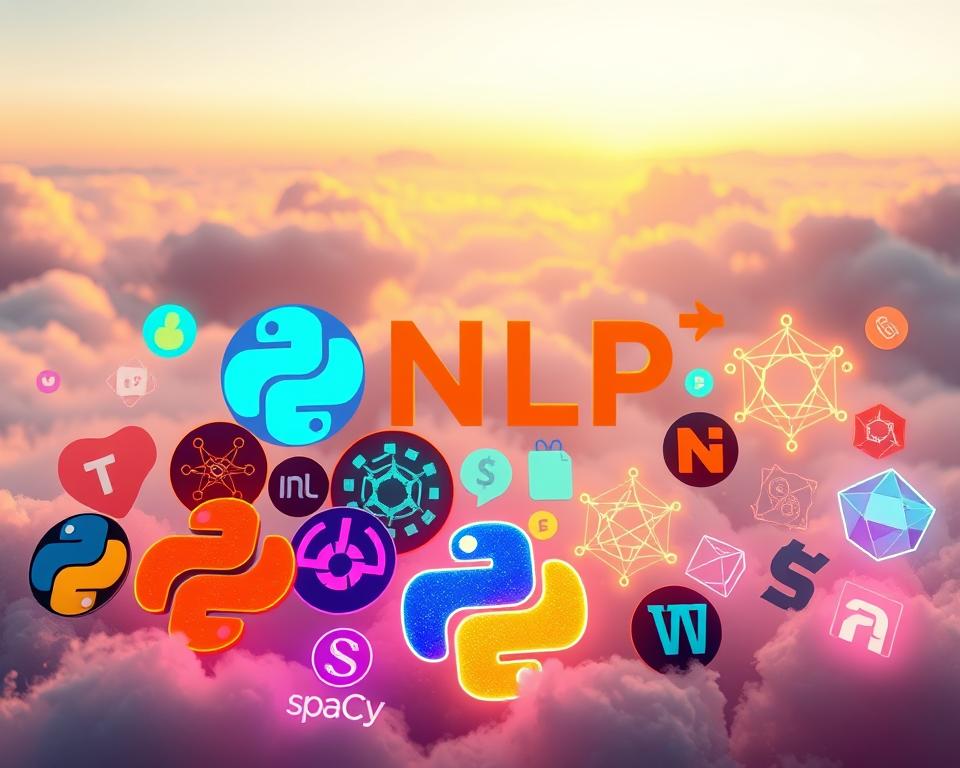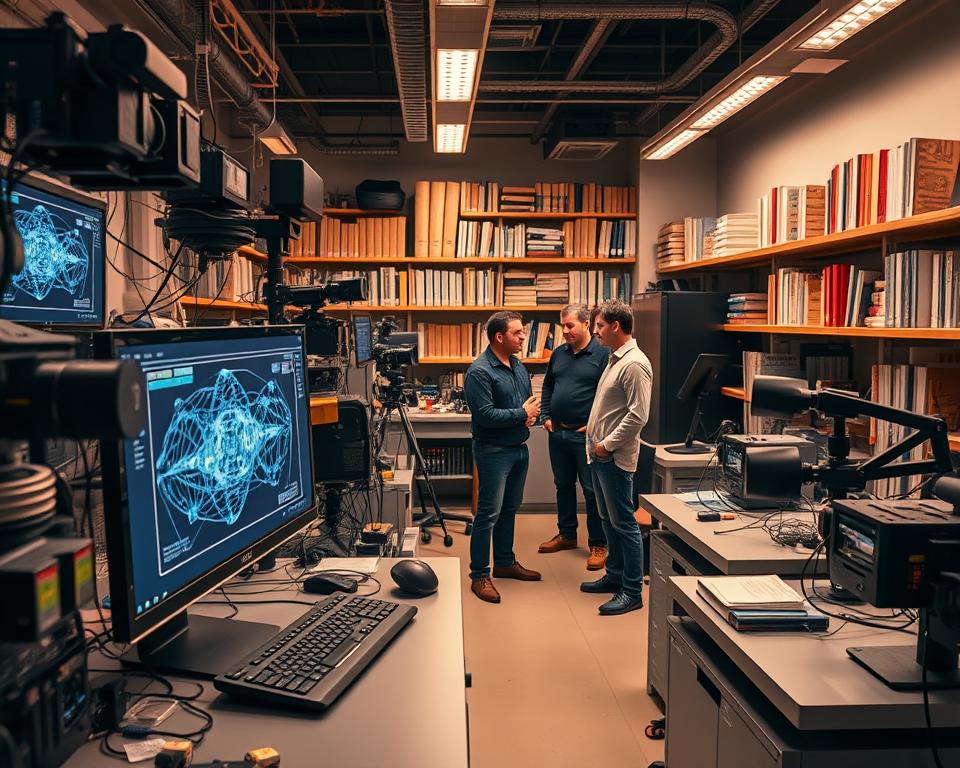The world of Artificial Intelligence (AI) and Machine Learning (ML) has grown a lot. Python is now a top choice for making these technologies.
Python’s easy-to-use nature and wide range of libraries make it perfect for creating AI models. The demand for good Machine Learning libraries has led to new ideas in the field.
This article will look at the top Python libraries for AI and ML. We’ll see how they work and their advantages.
Table of Contents
Key Takeaways
- Understanding the role of Python in AI and ML development
- Exploring key Python libraries for AI and ML
- Identifying the benefits of using these libraries
- Learning about the applications of these libraries in real-world scenarios
- Gaining insights into the future of AI and ML with Python
The Role of Python in Modern AI and Machine Learning
Python is a top choice for AI and machine learning. It’s easy to use and has a wide range of libraries. This makes it perfect for developers and researchers.
Why Python Dominates the AI Landscape
Python is a leader in AI for several reasons.
Readability and Ease of Use
Python’s code is intuitive and easy to read. This makes it great for beginners in AI and machine learning. It lets developers concentrate on their code’s logic without getting lost in complex syntax.
Extensive Community Support
The Python community is huge and active. It offers extensive support through forums, documentation, and libraries. This support is key for solving problems and keeping up with AI and ML updates.
Key Advantages of Python for AI Development
Python has many benefits for AI development.
Rich Ecosystem of Libraries
Python has a vast library collection. This includes TensorFlow, PyTorch, and Scikit-learn, crucial for AI model building. These libraries offer pre-built functions for complex tasks, speeding up development.
Integration Capabilities
Python works well with other languages and tools. This makes it a versatile choice for AI projects. It lets developers use the best of different languages and technologies in their AI work.
Essential Data Manipulation Libraries
Python’s data manipulation tools are key for AI and ML. Libraries like NumPy, Pandas, and Dask are crucial. They help work with big data efficiently.
NumPy: The Foundation of Scientific Computing
NumPy is at the heart of scientific computing in Python. It supports large arrays and matrices. It’s the base for the scientific Python world.
Multi-dimensional Arrays and Mathematical Functions
NumPy’s multi-dimensional arrays are its strongest point. They make working with big datasets easy. Plus, it has many mathematical functions for array operations.
| Library | Primary Use | Key Features |
|---|---|---|
| NumPy | Scientific Computing | Multi-dimensional arrays, Mathematical functions |
| Pandas | Data Analysis | DataFrames, Data Cleaning |
| Dask | Parallel Computing | Scalability, Parallelized operations |
Pandas: Data Analysis and Manipulation Tool
Pandas is built on NumPy. It’s made for handling structured data like spreadsheets and SQL tables.
DataFrames and Data Cleaning Capabilities
Pandas’ DataFrame is great for data manipulation and analysis. It has tools for data cleaning, like dealing with missing data and merging data.
Dask: Parallel Computing for Larger-than-Memory Data
Dask is a library for parallel computing. It makes big data workable by scaling libraries like NumPy and Pandas.
With parallel computing, Dask lets data scientists handle huge datasets. These datasets are too big for memory otherwise.
Top Python Libraries for AI and Machine Learning Development
Python is a top choice for AI and ML thanks to its vast library ecosystem. This ecosystem makes Python a go-to language for AI and machine learning.
Overview of the Python AI/ML Ecosystem
The Python AI/ML ecosystem is vast and covers all bases. It has libraries for data handling, visualization, deep learning, and natural language processing. This variety meets a wide range of needs.
Key Components of the Ecosystem:
- Data manipulation libraries like NumPy and Pandas
- Deep learning frameworks such as TensorFlow and PyTorch
- Machine learning libraries like Scikit-learn
- Natural Language Processing libraries including NLTK and spaCy
Selection Criteria for AI Libraries
Choosing the right AI libraries involves several key factors. Understanding these selection criteria is essential for picking the best libraries for your projects.
Performance Considerations
Performance is crucial in AI and ML development. Libraries that perform well can greatly improve your project’s efficiency.
Community Support and Documentation
A strong community and detailed documentation are vital. They offer the support and resources needed for successful library implementation.
Integration with Other Tools
Being able to integrate with other tools is key. Seamless integration boosts your AI project’s functionality and versatility.
Key Considerations for Library Selection:
- Evaluate the library’s performance capabilities
- Assess the quality of community support and documentation
- Consider the library’s ability to integrate with other tools
By weighing these factors, developers can make smart choices when picking AI libraries for their projects.
TensorFlow: Google’s Powerful Deep Learning Framework
TensorFlow is a key part of modern AI. It’s known for its flexibility and performance in deep learning. Google developed it, and now it’s used a lot in research and production.
Core Features and Capabilities
TensorFlow excels at complex computations. It uses a dataflow programming model. This makes it easy to build deep learning models.
Some of its main features are:
- Support for distributed training on large-scale datasets
- Extensive library of pre-built estimators and layers
- Seamless integration with other Google tools like Colab and Cloud AI Platform
TensorFlow 2.0 Improvements
TensorFlow 2.0 brought big changes. It introduced simplified APIs and better performance. The main improvements are:
- Eager execution by default, enhancing debugging capabilities
- Simplified model building with Keras integration
- Better support for distributed training
Real-world Applications and Use Cases
TensorFlow is used in many industries. It’s versatile for different AI tasks. Here are some examples:
Computer Vision Applications
TensorFlow is great for computer vision. It’s used for image classification, object detection, and segmentation. It’s perfect for working with big datasets.
Natural Language Processing Solutions
In NLP, TensorFlow helps with text classification, language translation, and sentiment analysis. It supports RNNs and transformers for sequence modeling.
TensorFlow keeps getting better. It’s a favorite among developers and researchers in deep learning.
PyTorch: Facebook’s Flexible Deep Learning Platform
PyTorch is known for its flexibility and ease of use. It’s a top choice for researchers and developers.
Dynamic Computational Graphs
PyTorch’s dynamic computational graphs are a big plus. They make model building flexible and easy. Unlike other frameworks, PyTorch’s graphs can change during use.
This makes it great for quick prototyping and research. It also makes debugging simpler, as you can see and change the graph while it runs.
PyTorch Lightning and Ecosystem
PyTorch Lightning is a tool that makes training deep learning models easier. It offers a structured way to organize PyTorch code. This helps in scaling and reproducing research.
The PyTorch ecosystem has many libraries and tools. These include TorchVision for computer vision and TorchText for natural language processing.
Industry Adoption and Research Applications
PyTorch is widely used in both the industry and academia. Its flexibility and ease of use are perfect for research applications. Quick prototyping and iteration are key here.
Academic Research Use Cases
In academia, PyTorch is used for many research tasks. This includes natural language processing and computer vision. Its dynamic graphs and modular design are great for trying out new models.
Production Implementations
In industry, PyTorch is used to deploy deep learning models. Companies use its robust production capabilities to run models at scale. This benefits from its flexibility and performance.
Scikit-learn: Machine Learning for Everyone
Scikit-learn is a top choice for machine learning beginners and experts. It offers a wide range of algorithms for various tasks. This makes it a key tool for anyone working with machine learning.
Comprehensive ML Algorithms
Scikit-learn has many algorithms for different tasks. These include:
- Classification: Algorithms for categorizing data into predefined classes.
- Regression: Techniques for predicting continuous outcomes.
- Clustering: Methods for grouping similar data points.
Classification and Regression Tools
It has tools for classification and regression. You can use Support Vector Machines (SVM), Linear Regression, and Logistic Regression. These are key for making predictive models.
Clustering Algorithms
Scikit-learn also has clustering algorithms like K-Means and Hierarchical Clustering. These are great for unsupervised learning tasks.
Preprocessing and Model Evaluation Tools
Scikit-learn also has tools for data prep and model checks. It helps with feature scaling, data normalization, and cross-validation. This ensures models are accurate and reliable.
When to Use Scikit-learn
Scikit-learn is great for projects needing many algorithms and strong data prep. It’s perfect for both research and production use. It’s easy to use and flexible. Whether you’re making a simple model or a complex pipeline, Scikit-learn is a valuable resource.
Keras: High-Level Neural Networks API
Keras leads in making deep learning easier, with a high-level API for quick prototyping. This makes it easy for developers to test and use neural networks fast. It speeds up the development process a lot.
User-Friendly Interface for Deep Learning
Keras has a simple interface for making deep learning models. It’s easy to use, so developers can focus on building and training models. They don’t have to worry about the complex architecture.
Key Features of Keras’ Interface:
- Simple, consistent API for building neural networks
- Easy to use, even for those new to deep learning
- Supports multiple backend engines, including TensorFlow
Integration with TensorFlow
Keras works well with TensorFlow, Google’s open-source machine learning library. This partnership boosts Keras’ abilities. It uses TensorFlow’s power and scalability.
The benefits of this integration include:
- Seamless interaction with TensorFlow’s low-level APIs
- Access to TensorFlow’s extensive ecosystem and tools
- Improved performance and scalability for large-scale deep learning projects
Rapid Prototyping Capabilities
Keras is great for quick prototyping. Its high-level API lets developers build, test, and improve neural networks fast.
Pre-trained Models and Transfer Learning
Keras makes it easy to use pre-trained models and transfer learning. This saves time and resources. It’s especially helpful when you have little training data.
| Feature | Description | Benefit |
|---|---|---|
| Pre-trained Models | Access to models trained on large datasets | Reduced training time and improved accuracy |
| Transfer Learning | Ability to adapt pre-trained models to new tasks | Enhanced model performance with less data |
Natural Language Processing Libraries
NLP libraries help machines understand and create human language. They make it possible for chatbots and sentiment analysis to work. These libraries have greatly helped NLP grow.
NLTK: Natural Language Toolkit
The Natural Language Toolkit (NLTK) is a key library for NLP. It has many tools for handling text, breaking it down, and managing large datasets.
Text Processing and Analysis
NLTK is great at text work. It can break down text, simplify words, and tag parts of speech. These tools help get text ready for NLP tasks.
spaCy: Industrial-Strength NLP
spaCy is a top NLP library known for its strong performance. It’s designed for fast and efficient text processing.
Named Entity Recognition and Dependency Parsing
spaCy is good at finding named entities and understanding text structure. It’s a top pick for tasks that need to grasp text’s meaning and structure.
Transformers: State-of-the-Art NLP Models
The Transformers library has changed NLP with its transformer models like BERT and GPT. These models lead in many NLP areas.
BERT, GPT, and Other Pre-trained Models
Transformers lets you use pre-trained models like BERT and GPT. These can be adjusted for tasks like text classification, answering questions, and translating languages.
| Library | Primary Function | Notable Features |
|---|---|---|
| NLTK | Text Processing | Tokenization, Stemming, Corpora Management |
| spaCy | Industrial-Strength NLP | Named Entity Recognition, Dependency Parsing |
| Transformers | Pre-trained Models | BERT, GPT, Language Translation |
Computer Vision and Image Processing Libraries
Python is a top choice for computer vision and image processing. It has many libraries that make these tasks easy and efficient. These tools help with everything from simple image tweaks to complex object detection.
OpenCV: Computer Vision Applications
OpenCV is a leading computer vision library. It offers tools for image and video processing, feature detection, and object recognition. It’s used in robotics, surveillance, and healthcare.
Image Processing Functions
OpenCV has many image processing functions. You can filter, threshold, and perform morphological operations. These tools help developers enhance and analyze images.
Object Detection Capabilities
OpenCV also has advanced object detection tools. You can use Haar cascades and deep learning detectors. These tools help detect objects accurately and efficiently.
Pillow: Python Imaging Library
Pillow is another key library for image processing in Python. It makes it easy to work with different image formats.
Specialized Vision Libraries
There are also specialized libraries for computer vision. Scikit-image focuses on image processing algorithms. Imgauge is for image augmentation.
| Library | Primary Function | Key Features |
|---|---|---|
| OpenCV | Computer Vision | Image Processing, Object Detection, Feature Detection |
| Pillow | Image Processing | Image Manipulation, File Format Support |
| scikit-image | Image Processing Algorithms | Filtering, Thresholding, Morphology |
These libraries help developers with a wide range of tasks. From basic image processing to complex object recognition and tracking.
Data Visualization Libraries for AI Projects
In AI, data visualization libraries are key for understanding complex data. They help developers show AI insights clearly and simply.
Comprehensive Visualization with Matplotlib
Matplotlib is a top choice in Python for data visualization. It offers tools for making high-quality 2D and 3D plots. Its wide range of features makes it perfect for AI and machine learning projects.
Statistical Data Visualization using Seaborn
Seaborn uses Matplotlib to create beautiful, informative graphics. It’s great for looking at datasets and understanding data distribution. This is very important in AI analysis.
Interactive Visualizations with Plotly
Plotly is known for making interactive, web-based visualizations. This interactivity is key in AI projects. It lets users dive deep into data and find insights missed by static plots.
Dashboard Creation for AI Results
These libraries are also great for making dashboards for AI results. By using Matplotlib, Seaborn, and Plotly together, developers can make dashboards. These dashboards are both comprehensive and interactive, showing AI findings well.
Data visualization libraries are crucial in AI projects. They help in understanding and showing complex data insights. By using these tools, developers and data scientists can make their AI results more impactful and understandable.
Model Deployment and Production Libraries
Model deployment connects machine learning models to real-world use. It puts trained models in places where they can make predictions or decisions.
Flask and FastAPI: Creating ML APIs
Flask and FastAPI are top picks for Python web frameworks. Flask is simple and flexible, perfect for smaller projects. FastAPI is fast and has great API docs, ideal for big projects.
For example, you can use Flask to make a simple API for a model like this:
from flask import Flask, request, jsonify
app = Flask(__name__)
@app.route(‘/predict’, methods=[‘POST’])
def predict():
data = request.get_json()
# Process data and make prediction
return jsonify({‘prediction’: prediction})
if __name__ == ‘__main__’:
app.run(debug=True)
MLflow: Managing the ML Lifecycle
MLflow is a platform for managing the machine learning lifecycle. It tracks experiments, manages models, and deploys them. MLflow helps teams work together and ensures reproducibility.
MLflow’s key features are:
- Experiment tracking
- Model management
- Hyperparameter tuning
TensorFlow Serving and PyTorch Serve
TensorFlow Serving and PyTorch Serve are for deploying models. TensorFlow Serving is for production and has model versions and rollouts. PyTorch Serve is flexible for PyTorch models.
Scalable Model Deployment
Scalable deployment is key for handling lots of requests. TensorFlow Serving and PyTorch Serve support this. TensorFlow Serving works with Kubernetes for better management.
| Library | Primary Use | Scalability |
|---|---|---|
| Flask | Creating ML APIs | Medium |
| FastAPI | Creating ML APIs | High |
| MLflow | Managing ML Lifecycle | High |
| TensorFlow Serving | Deploying TF Models | High |
| PyTorch Serve | Deploying PyTorch Models | High |
Emerging Libraries and Future Trends
New libraries in the Python world are changing how we work with AI and Machine Learning. These tools are fixing old problems and opening new doors for research and use.
JAX: Accelerated Machine Learning Research
JAX is a library from Google made for high-level numerical computing. It’s perfect for modern machine learning and deep learning. Its main features are:
- Just-In-Time (JIT) compilation for better performance
- Automatic vectorization for quick computation
- Support for parallelization and distributed computing
JAX stands out for speeding up ML research. It offers a flexible and efficient way to compute.
Fast.ai: Making Deep Learning Accessible
Fast.ai makes deep learning easier by offering high-level interfaces and pre-trained models. Its benefits are:
- Easier deep learning model development
- Pre-trained models for different tasks
- Focus on practical use and real-world examples
Fast.ai is known for making deep learning available to more people.
AutoML Libraries and Tools
AutoML libraries are becoming more popular. They make choosing models, tuning parameters, and deploying easier. Some top AutoML tools are:
- H2O AutoML
- Google AutoML
- PyTorch AutoML
Future Directions in Python AI Libraries
As AI grows, Python libraries will too. We’ll see more AutoML, better support for explainable AI (XAI), and handling big data more efficiently. These developments will shape AI and ML’s future.
Key Takeaways: Libraries like JAX and Fast.ai are changing AI development. AutoML tools are making AI simpler and more accessible.
“The future of AI is not just about more powerful models, but also about making these technologies accessible and usable for everyone.” –
Conclusion
Python AI Libraries have changed the game in Artificial Intelligence and Machine Learning. They give developers the tools they need to build complex models. Libraries like TensorFlow, PyTorch, Scikit-learn, and Keras are key in AI development.
The Future of AI is bright, thanks to these libraries. As AI gets smarter, we’ll need even better libraries. New libraries like JAX and Fast.ai are already making a big impact.
Using these libraries, developers can make groundbreaking AI solutions. This progress will help many industries grow. Keeping up with new developments in Python AI Libraries is essential for AI and Machine Learning experts.


















